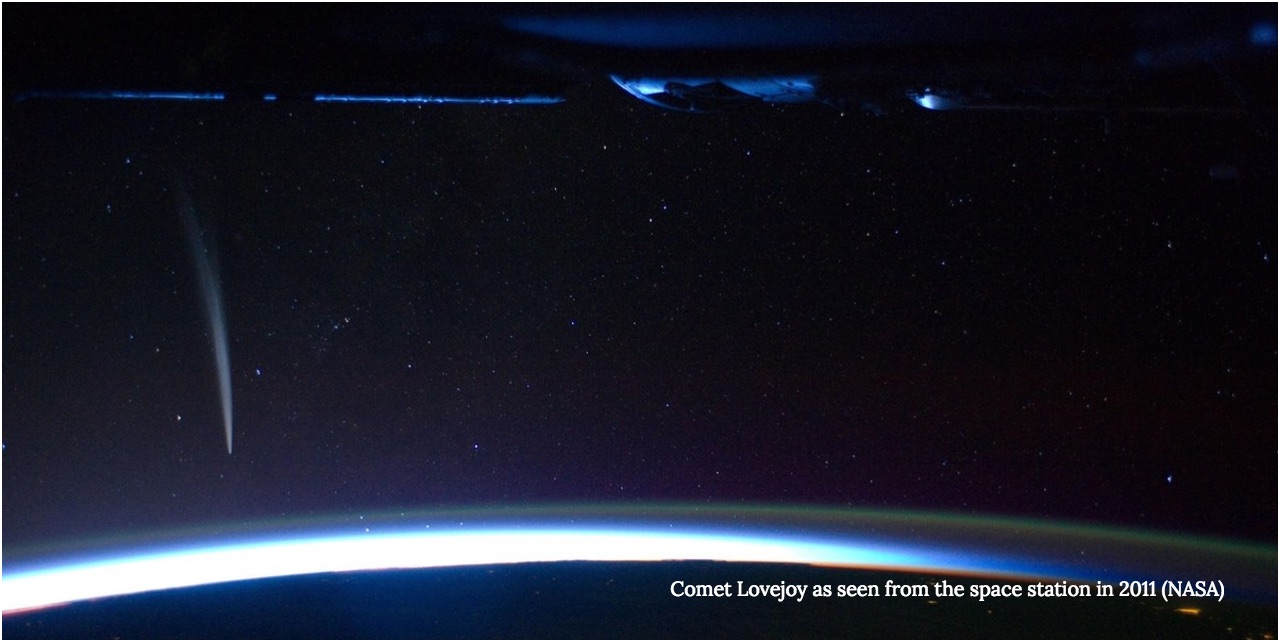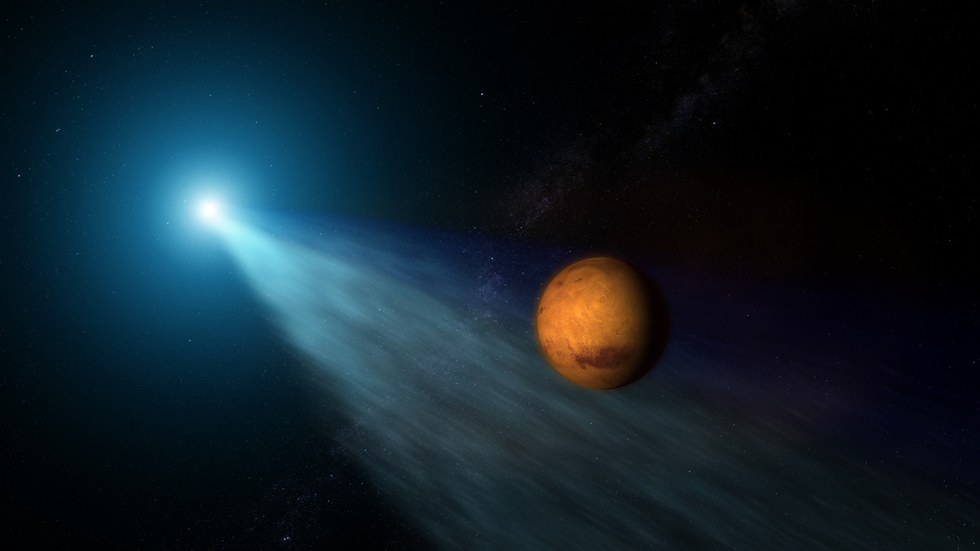What to Do With Nukes? Blow Up Dangerous Comets, of Course

When the comet Siding Spring was detected early in 2013, initial predictions suggested that there was a "non-negligible chance" that it would hit Mars the following year. Thought to be up to half a mile wide, the comet ended up missing the Red Planet by a cosmic hair's breadth, much to the disappointment of computational geophysicist Cathy Plesko.
"I think I was the most excited person on the planet!" Plesko recalled recently. "Because if it would have hit Mars, I would have had a published thesis with predictions about how that was going to go."
Plesko is based at the Los Alamos National Laboratory in New Mexico and works with a team of scientists in a number of institutions who are focused on impacts on planetary bodies and simulations of impact mitigation techniques. An impact on Mars would have been an incredible stroke of luck — her 2009 Ph.D. research was about the effects of comet impacts on Mars. If Siding Spring had slammed into the Martian surface in 2014, the event would have put her published theories to the test.
For the first time in human history, we would have had a ringside view of the devastation unleashed during a massive impact on a planetary body. The sheer energy generated by the cometary impact would have been witnessed not only by countless telescopes on Earth, but also by an armada of Mars satellites that would have watched and recorded what it's actually like for an atmosphere to get hit by a major comet. What's more, NASA's Mars rovers Curiosity and Opportunity would have felt what it's like to get hit by a comet, making measurements of the effects on the ground — that is, if they survived.
It didn't happen, but the historic flyby did underscore the potentially devastating threat hanging over life on Earth. What if Siding Spring had been aimed at Earth instead of Mars?
RELATED: Why a Mars Comet Impact Would be Awesome
Though much of our concern is currently focused on the threat of asteroid impacts, Plesko has her sights set on the more unpredictable foe.
Breaking space news, the latest updates on rocket launches, skywatching events and more!
"The real 'gotcha' we need to worry about — that's a much lower probability, but a much bigger danger — would be a short-warning time incoming comet," she told Seeker after presenting her research at the December meeting of the American Geophysical Union (AGU) in San Francisco, Calif.
Keep in mind that Siding Spring was discovered in January 2013 and the Mars flyby happened in the October of 2014 — only 22 months lapsed from discovery to flyby. If the comet had been headed toward Earth, there wouldn't have been enough time to plan, build and launch a mission to intercept it.
"The point with Siding Spring was that it wouldn't have taken much of a trajectory change for it to have been pointed at the Earth," said Plesko. "If it had been pointed at Earth, we wouldn't have known until it was very close whether or not it was going to hit Earth. We would have had to have mounted a response."
Black Cat in a Coal Bin
Before an appropriate response can be worked out, however, we must first understand why comets are such an unpredictable phenomenon.
When surveying the solar system for errant space rocks, astronomers typically look around the equatorial plane. This is the imaginary disk around which the planets orbit the sun. There are some erratic asteroids that, through a collision or some gravitational interaction in the past, orbit well beyond the equatorial plane, but for the most part we have a good idea where a large incoming asteroid is going to come from. And when we do detect a particularly scary space rock, we'd have years, decades or even centuries of notice before we started losing sleep over it.
Long period comets, on the other hand, do not originate from the equatorial plane. They populate a distant region well beyond the planets and even beyond the heliosphere, the sun's magnetic sphere of influence. Called the Oort Cloud, this hypothetical region surrounds the solar system like a shell, and is thought to be up to one light-year distant. Any one of these comets could careen into the inner solar system from any angle; from above, below, from the side, or from the glare of the sun. This makes them very hard to survey.
Although comets become bright and beautiful objects as they get close to the sun — solar heating causes the ices in their nuclei to vent into space, producing a huge coma and tails, which scatter sunlight — when they are far away, these ancient clumps of ice and rock are extremely dark, complicating efforts to find them.
"They are about as reflective as coal… like looking for a black cat in a coal bin," said Plesko — except that the coal bin is infinitesimal. This observational difficulty only adds to the challenge. If you can't see comets and don't know where they are coming from, you may only have a few months to mount a response should one appear out of the dark.
Cannonballs and Nuclear Warheads
Plesko develops computer code that runs on supercomputers and, with the techniques she's developing, can model many different strategies for dealing with these incoming comet threats.
One strategy for knocking a comet off course, if we have enough time before the comet is predicted to hit, is to fire a kinetic impactor at the comet's nucleus, a bit like a space age cannonball delivered to the comet via rocket to slightly nudge the mass off course. If we send up many of these impactors, even the slightest nudge could be enough to modify the comet's orbit around the sun to avoid slamming into Earth.
This strategy will hopefully soon be tested when the European Space Agency and NASA launch a joint mission to impact asteroid Didymos' 150 meter-wide moonlet, informally called "Didymoon". NASA's Double Asteroid Redirection Test (DART) spacecraft will hit the moonlet while the European Asteroid Impact Mission (AIM) spacecraft observes from afar. This will be the first test to see if a kinetic impactor can indeed have a measurable effect on an asteroid. Though NASA has hit a comet nucleus with an impactor in 2005 during the Deep Impact mission, leaving a 150-meter-wide crater in comet Tempel 1's surface, that mission was intended to excavate material from the nucleus to see what the comet was made of, not to deflect it.
RELATED: We're Planning to Shoot an Asteroid to See What Happens
But for this kinetic impactor strategy to work against a large incoming comet, we would need a lot of lead time to stand a chance of it working, so if we're short on time, we'd need something a little more energetic.
If there's one thing we've learned from science fiction it's that when a comet threatens Earth, we just need to land a nuclear bomb on the surface to obliterate the thing. But the idea that a single nuke can blow a comet to smithereens is, well, science fiction. And even if the nuke managed the feat, the fallout from such an effort would likely not be to the benefit of humankind. Instead of one incoming comet, we'll have many pieces of incoming comet that could blanket-bomb an entire hemisphere of our planet. Depending on what the comet is made of (still a pretty big unknown), a single nuclear explosion might have no effect on protecting Earth.
But that's not to say that nuclear weapons shouldn't be used — we just need to use them right. And many nuclear weapons would need to be ready to launch at a moment's notice.
Going Nuclear
Plesko envisages a fleet of rockets outfitted with nuclear warheads that could be launched as soon as a comet threat is deemed imminent. Although there's an extremely low probability of a comet turning up at all, if it does, at least we'd have a plan in place to deal with the existential threat. There's still a lot of work to be done in characterizing comets, what they are made of and how they might be affected by a nuclear detonation in space. Because comets are composed of a high percentage of volatile ices, many waves of nuclear missiles exploding near a comet would likely "ablate" layers of the comet away, pushing it off course and vaporizing much of its mass. Disrupt a comet enough, and Earth might be saved.
"What we'd need to do is to mass produce these units [rockets and warheads] that can sit in a clean room, ready to go, and maybe be refreshed every 50 to 100 years, so they're ready to launch," said Plesko, likening the idea to keeping a fire extinguisher in the house.
Such a system is not unprecedented. Globally, there are thousands of nuclear warheads and ballistic missiles being stored and maintained, ready to launch at a moment's notice; huge amounts of funding is committed to this Cold War era exercise. When it became clear that nuclear war was a zero-sum game and as the Cold War started to thaw, nations like the U.S. and Russia agreed to reduce their stockpiles. These (hopefully) defunct weapons of mass destruction could be refurbished with another — extraterrestrial — target in mind.
"If we had something big like that coming right at us, we might have to use everybody's [nuclear] stockpiles to vaporize the thing," Plesko speculated.
RELATED: Nuking Asteroids: It's a Megaton Of Fun!
Before a system like this can be put into place, she pointed out that we still have a lot to learn about mysterious long-period comets that appear with little warning. As demonstrated by Europe's Rosetta mission to comet 67P/Churyumov–Gerasimenko, these dusty solar system bodies hold many surprises. Even though 67P is a short-period comet originating from the Kuiper Belt (far closer to the sun than the Oort Cloud where long-period comets originate) and was well observed, it wasn't until the spacecraft actually went there that we realized it was a double-lobed "rubber ducky" shape. This emphasizes the need for further comet studies, possibly including surveys of the Oort Cloud.
"An Oort Cloud survey would be incredibly technically challenging," said Plesko, "but some day it would be important important to do that."
An Earth-threatening comet may not be imminent, but one day it could be. This uncertainty isn't lost on scientists who know that it would be extremely challenging to get governments to fund a standing nuclear preparedness program against extraterrestrial threats.
But if another comet like Siding Spring appears in the night sky, and astronomers realize that it has Earth in the crosshairs, what will we be able to do? For now, not a whole lot.
WATCH VIDEO: What Happens When Comets Hit the Sun?
Originally published on Seeker.
Ian O'Neill is a media relations specialist at NASA's Jet Propulsion Laboratory (JPL) in Southern California. Prior to joining JPL, he served as editor for the Astronomical Society of the Pacific‘s Mercury magazine and Mercury Online and contributed articles to a number of other publications, including Space.com, Space.com, Live Science, HISTORY.com, Scientific American. Ian holds a Ph.D in solar physics and a master's degree in planetary and space physics.


